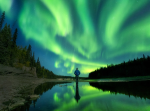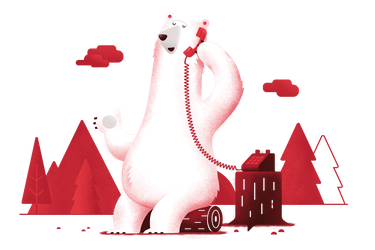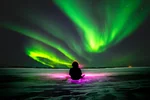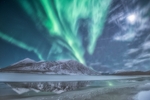Northern Lights explained: a guide to this natural wonder
When travellers talk about the awe-inspiring majesty of the Northern Lights in Canada, they describe dancing tendrils of emerald, scarlet, and amethyst, a visual symphony of radiant light against the endless backdrop of the night sky. This enigmatic spectacle — known scientifically as the aurora borealis —has enchanted man through the ages. This dazzling light show is far more than just a feast for the eyes. It's a demonstration of earth's interactions with the universe, an atmospheric phenomenon seen through light and colour. Intrigued? The travel experts at northernlightscanada.com specialize in planning trips to see the aurora borealis in Canada. Join us as we delve deeper into the mysteries of this mesmerizing natural wonder and uncover the facts behind the splendour of the Northern Lights.

Exploring the enigmatic aurora borealis
Origins of the Northern Lights
The Northern Lights, also called aurora borealis, happen when electrically charged particles from the sun hit the Earth's atmosphere (1). The sun sends out a constant stream of these particles, referred to as a solar wind. When this solar wind hits the gases in the earth’s upper atmosphere, they light up, causing the aurora.
Geographical distribution
The aurora are mostly seen in the polar regions of the Earth. This means you can usually see them best near the North Pole and South Pole. So, places near these poles, like Canada, Alaska, Norway, and Antarctica are great spots to see them.

Why choose Canada?
Canada (2) gives you a front-row seat to the Northern Lights show! The northern regions of the country sit right under a big ring around the North Pole called the "Auroral Oval" where there is a high occurrence of the Northern Lights during solar activity. This means when the solar wind is active, Canada is one of the best places in the world to see this amazing light show.
Our travel experts help travellers plan their trips to Canada to see this amazing natural wonder. Working with hand-picked suppliers, we put together perfect itineraries that include guided Northern Lights tours as well as other highlights in each destination.

Keep reading or chat with one of our local travel experts. We’re passionate about Canada and can help you at any stage of your vacation planning.
The role of charged particles
Solar wind and magnetosphere interaction
Think of solar wind as a gust of tiny particles blowing from the Sun towards the Earth. When this wind reaches us, it bumps into Earth's magnetosphere, a sort of protective shield around our planet, and this starts the magic of the Northern Lights.
Excitation of atmospheric gases
When those solar particles hit the gases in our atmosphere, like oxygen and nitrogen, they give them a little jolt of energy, or "excite" them. This is like charging up a glow stick. Once these gases have energy, they release it as beautiful glowing lights we see as the Northern Lights.
How are northern lights formed?
When there is more solar activity, the Northern Lights are usually more dramatic and can be seen in more places.
Electron and proton precipitation
The tiny particles that fly from the Sun towards Earth in the solar wind are mostly electrons and protons. When they meet Earth's atmosphere, these particles "rain down" or "precipitate." As they drop, they light up the sky, creating the Northern Lights.

Auroral ones and shapes
The Northern Lights appear in a ring around the poles called "auroral zones." They can take many shapes, like arcs, spirals, or curtains. They change shape as the particles from the sun move around in the sky. So, no two Northern Lights shows are ever the same!

Conclusion
The Northern Lights are one of the most spectacular natural wonders that can be seen on the earth and there are limited places to see them. Canada, with its Northern regions under the Auroral Oval, is one of the best places in the world to witness this life-changing phenomenon.
At NorthernLightsCanada.com we craft unforgettable Canadian vacations designed around your needs and interests. Our local travel experts take care of all the details from planning through travel. All you need to do is relax and make travel memories. Our Northern Lights tours in Canada included guided viewing excursions, as well as other regional activities, including dog sledding, wildlife viewing, hot springs, and spas.
Popular Northern Lights Trips in 2023-24
Aurora and Astronomy in Churchill
This truly unique trip lets you engage with scientists and researchers at an active research facility, the Churchill Northern Studies Centre. A unique learning vacation, you’ll stay at the centre, and take part in research presentations and cultural workshops. There’s also outdoor activities to explore the scenic winter landscape.
Trip length (number of nights): 7
Nights in Churchill: 3
Aurora viewing evenings: 3
Northern Lights of the Yukon
You’ll get four separate opportunities to take in the wonder of the Northern Lights on this five-night, six-day itinerary. Travel from the coastal city of Vancouver to the largest city in northern Canada, Whitehorse. Daytime activities include dogsledding and Whitehorse cultural tours.
Trip length (number of nights): 5
Nights in Whitehorse: 4
Aurora viewing evenings: 4
Why book your trip with Fresh Tracks Canada?
Unforgettable Canadian vacations made just for you
Enjoy local expertise and guidance with a fully planned itinerary. Personalize your trip by adding extra time in Canada at the start or end of your Northern Lights tour.
We take care of all the details
Relax and focus on making memories. Let us make all of the bookings for you, including your guided Northern Lights tour, hotels, excursions and activities, and transfers.
Support when you need it
We’re here to make sure you get the inside scoop before you even leave home. And you can relax on your vacation because you know that we’re a phone call away if you have any questions while you’re in Canada.
Frequently asked questions
How long do the Northern Lights last?
The Northern Lights can be quite quick, only showing up for a few minutes, or they can stick around for several hours. It really depends on how active the sun is and the weather here on Earth.
Why are the Northern Lights only in the north?
The aurora is not only seen in the North. There are Southern Lights too, near the South Pole! In the Northern Hemisphere, we call them Northern Lights. They show up near the poles because of the way Earth's magnetic field guides the solar particles.
What is the best way to see the Northern Lights?
The best way to see the Northern Lights is to find a dark spot away from city lights on a clear night. It's also best to go during colder months when the nights are longer. We highly recommend a guided excursion for comfort and for the best areas to see the lights. Our itineraries include multi-night viewings for your best chances of seeing the lights on your trip.
Which direction do you look for the Northern Lights?
In most places in Canada, you should look toward the northern part of the sky.
How to spot the Northern Lights?
To spot the Northern Lights, you need to watch for a glow or light curtain in the sky. Sometimes, they start as a faint white light and then grow in color and intensity. It’s best to go out late at night and far away from any light pollution.
How to plan a trip to see the Northern Lights?
Plan your trip during the colder months from late fall to early spring. Pick one of the many locations in Canada known for its Northern Lights viewing. Check the weather for clear skies and also check an Aurora forecast online to learn your best chances of seeing them.
What are the two main colors of the Northern Lights?
The two main colors of the Northern Lights are green and pink. These colors are caused by different gases in our atmosphere getting excited by the sun's particles.
How much does it cost to see the Northern Lights ?
The cost to see the Northern lights depends on the tour itinerary that you choose. There are a variety of offerings, starting at $1,320 and going to $5,360 USD.
Explore Northern Lights by region
Discuss your Northern Lights tour with a Canadian travel expert


Sign up for travel inspiration
Our newsletter is full of travel tips and local insights for your Northern Lights tour in Canada.


